Data Deprecation with Confidence: A Step-by-Step Guide
In today’s fast-paced environment, organizations are constantly evolving their data ecosystems to keep up with changing business requirements and technological advancements. As new data sources and models are introduced to the data mart, it becomes crucial to periodically assess and migrate outdated or irrelevant data to maintain a high data quality. However, the process of deprecating data sources and fields can be complex and challenging, as it requires careful consideration of the potential impact on downstream processes, applications, and stakeholders.
In this article, we will explore the importance of data deprecation, discuss the key factors to consider when performing impact analysis, and provide a step-by-step guide on how to confidently deprecate data sources and fields using the Select Star platform.
Why Deprecate Data?
Data deprecation refers to the process of identifying and retiring data models or fields that are no longer relevant, reliable, or compliant with current business needs. There are several reasons why organizations may choose to deprecate data, including outdated information, changes in business requirements, data quality issues, and compliance or regulatory considerations.
Deprecating old data models is essential for maintaining a business-relevant and trustworthy data ecosystem. By removing unnecessary data, organizations can improve data processing efficiency, and ensure that users are accessing the most accurate and current information.
Another important aspect to consider in this process is the company’s data platform costs. By identifying and retiring data that is no longer relevant, organizations can reduce storage costs, and related compute costs of keeping that data up-to-date. It also reduces maintenance and support cost from users accidentally using that data. Additionally, removing obsolete data models or fields often result in faster query performance and reduced compute costs. By focusing on maintaining only the most valuable and relevant data, companies can optimize their data platform investments and allocate resources towards initiatives that drive business value.
The Complexity of Data Deprecation
If data deprecation has so many benefits, why don’t we do it more often? The complexity of data deprecation lies in the numerous dependencies and relationships that exist within an organization’s data ecosystem. Improper data deprecation can lead to unexpected consequences, such as disruption of critical business processes, breaking downstream applications, or causing data inconsistencies. Without a clear understanding of these dependencies, organizations risk disrupting critical business operations or introducing data inconsistencies.
In addition, the lack of clear ownership and governance policies around data deprecation can lead to confusion and hesitation among stakeholders, making it difficult to reach consensus on what data should be retired and when. As a result, many organizations opt to retain outdated or redundant data, leading to a cluttered and inefficient data ecosystem.
A Step-by-Step Guide to Data Deprecation
While it can be complex, a well-defined, step-by-step approach ensures that data deprecation is handled smoothly and without disrupting business operations. In this guide, we will walk you through the essential steps to effectively deprecate data, from initial assessment to final implementation:
- Identify potential data for deprecation
- Conduct impact analysis
- Develop a deprecation plan
- Implement the deprecation
- Monitor and validate post-deprecation
Step 1: Identify potential data for deprecation
Start by establishing clear criteria for selecting data sources and fields for deprecation. These criteria may include factors such as data age, relevance to current business needs, data quality issues, and compliance requirements. Select Star’s data discovery and profiling capabilities can help identify potential deprecation candidates based on usage patterns, data quality metrics, and business metadata.
For example, in this Table page you can see technical and business owners of dim_product table, when it was created and last refreshed, how popular it is, and if it has any mentions or discussions. If an object hasn’t been refreshed in a long time, or there is a discussion that the data in it is coming from a system that is no longer in use, it might be a good candidate for deprecation.
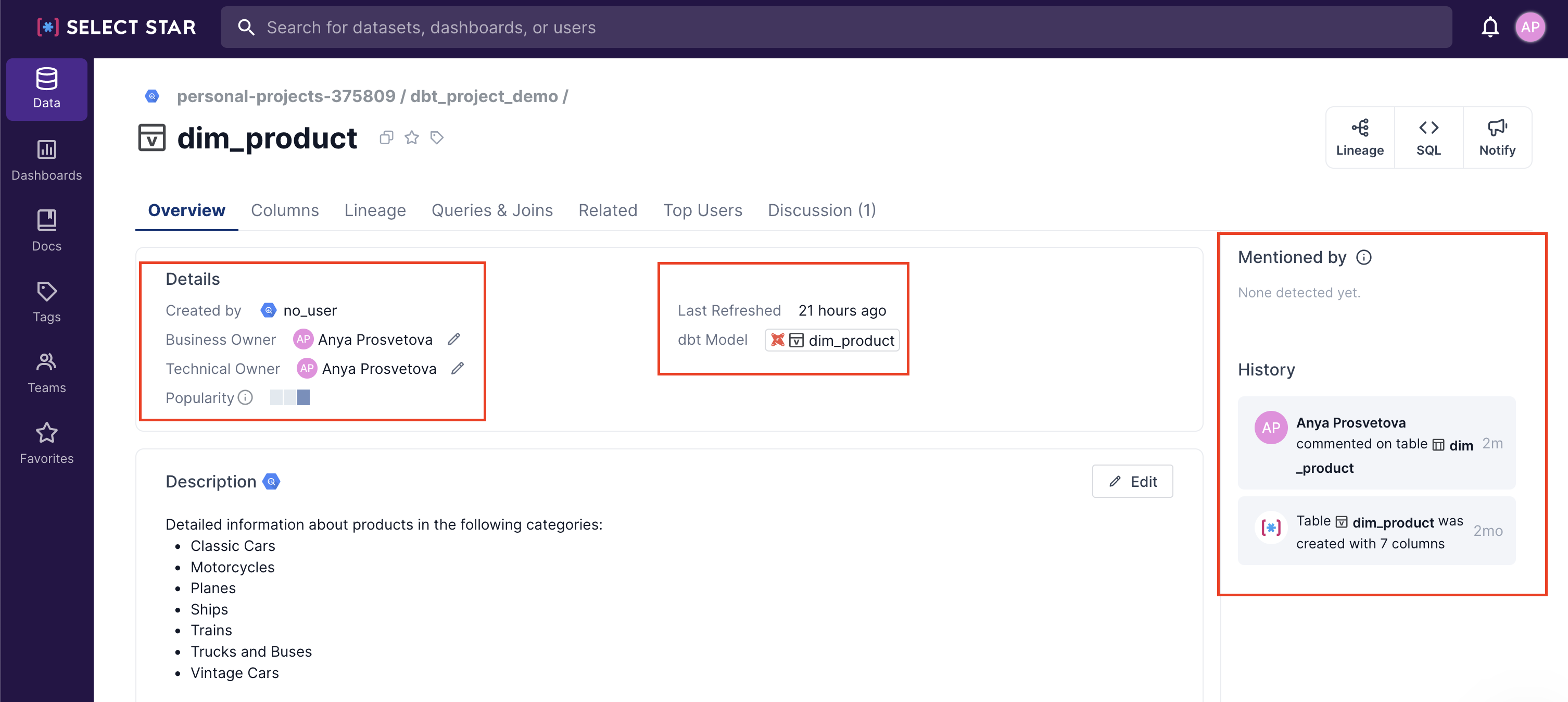
Step 2: Conduct impact analysis
Before proceeding with data deprecation, it is crucial to conduct a thorough impact analysis to understand the potential consequences of retiring specific data sources or fields. There are several key factors to consider:
- Data lineage and dependencies,
- Data usage and consumption patterns,
- Downstream processes and applications, and
- Business and regulatory requirements.
2.1 Data lineage and dependencies
Understanding how the data flows through various systems and processes is essential to identify potential downstream impacts. Select Star’s automated data lineage and auto-generated ERD (Entity-Relationship Diagram) features provides a clear visual representation of how data is connected and propagated across the organization.
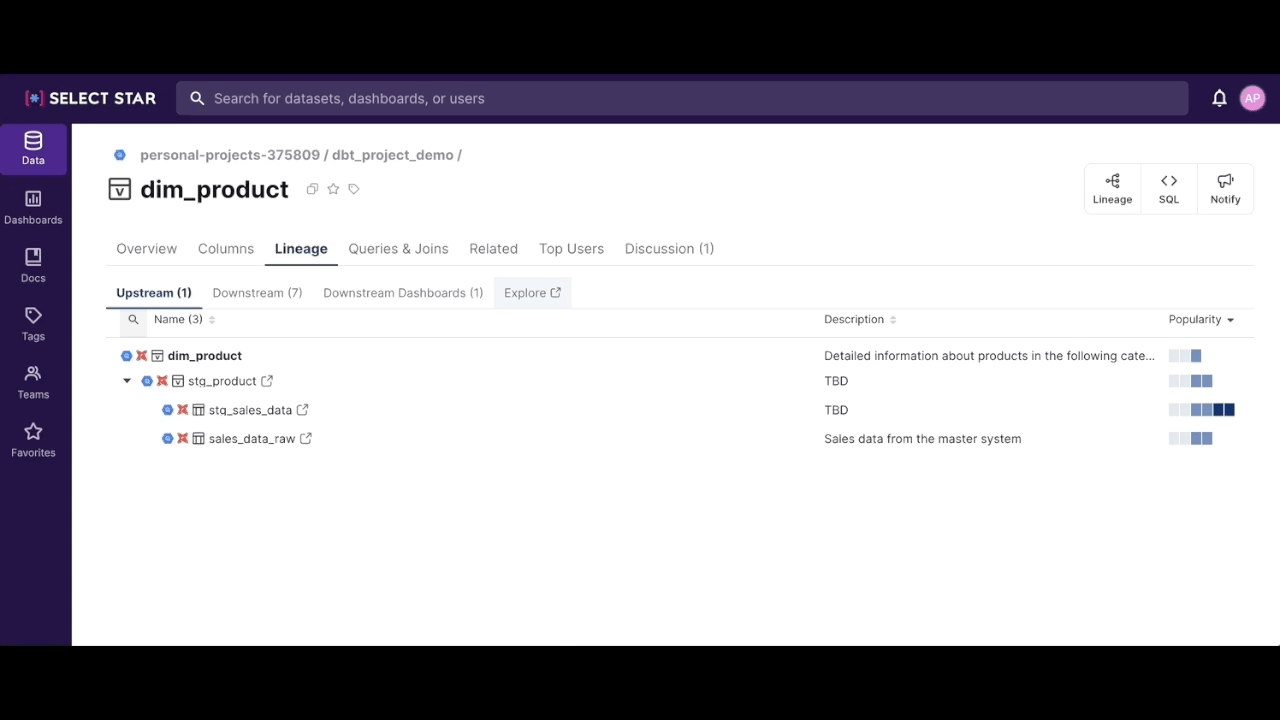
If you are planning to deprecate specific fields from a data source, you can drill down into usage of individual fields or use Field Usage labels in Select Star to understand how the column is used in the downstream table, view or dashboard. From this view, you can also open the SQL query for a specific table to understand the field usage better.

2.2 Data usage and consumption patterns
Analyzing how frequently the data is accessed and by whom helps to determine its relevance and criticality. Select Star offers data usage and popularity metrics that give insights into the utilization of specific data sources and fields. Use filters to see data assets that are inactive or have a certain level of popularity.
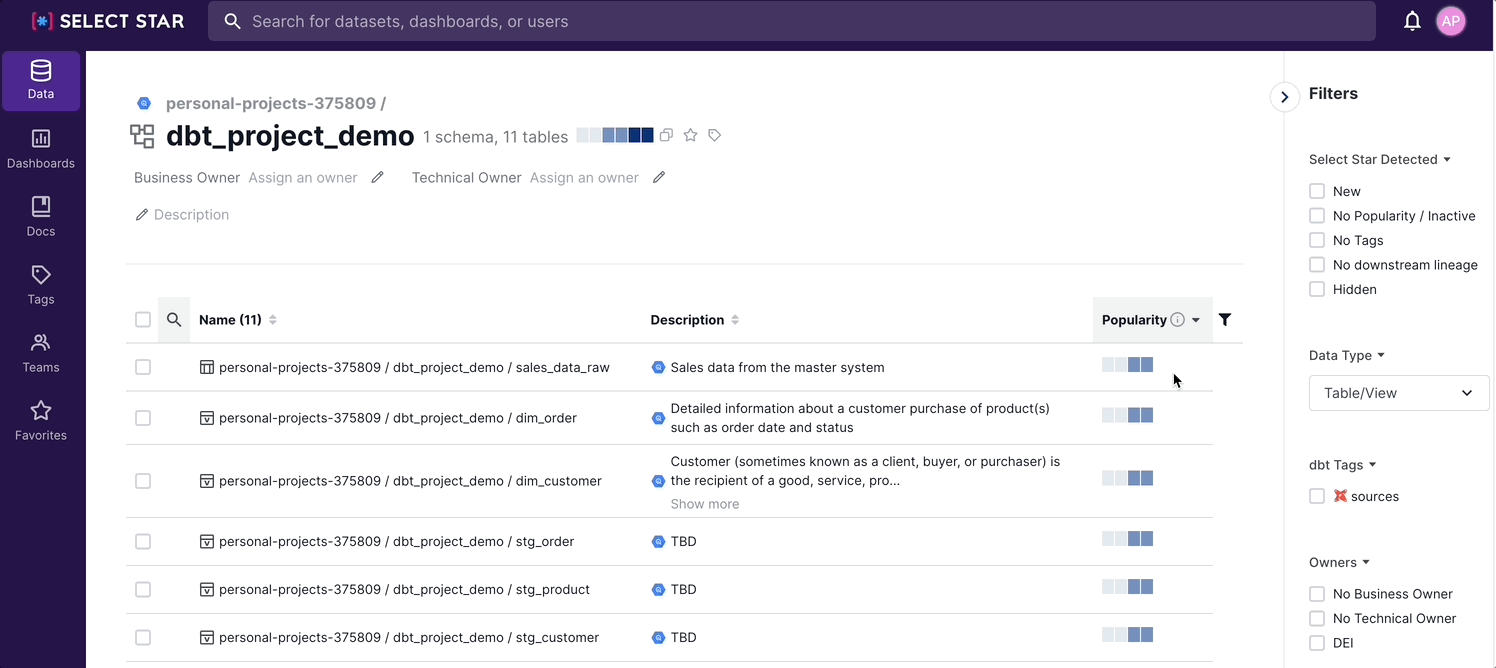
2.3 Downstream processes and applications
Identifying the systems, reports, and applications that rely on the data is crucial to assess the potential disruption caused by deprecation. Select Star’s integration with ETL and BI tools enables organizations to understand the business context and significance of data assets. In the example below, you can filter the lineage for a specific table to see in which dbt models or Tableau dashboards this table sis used.
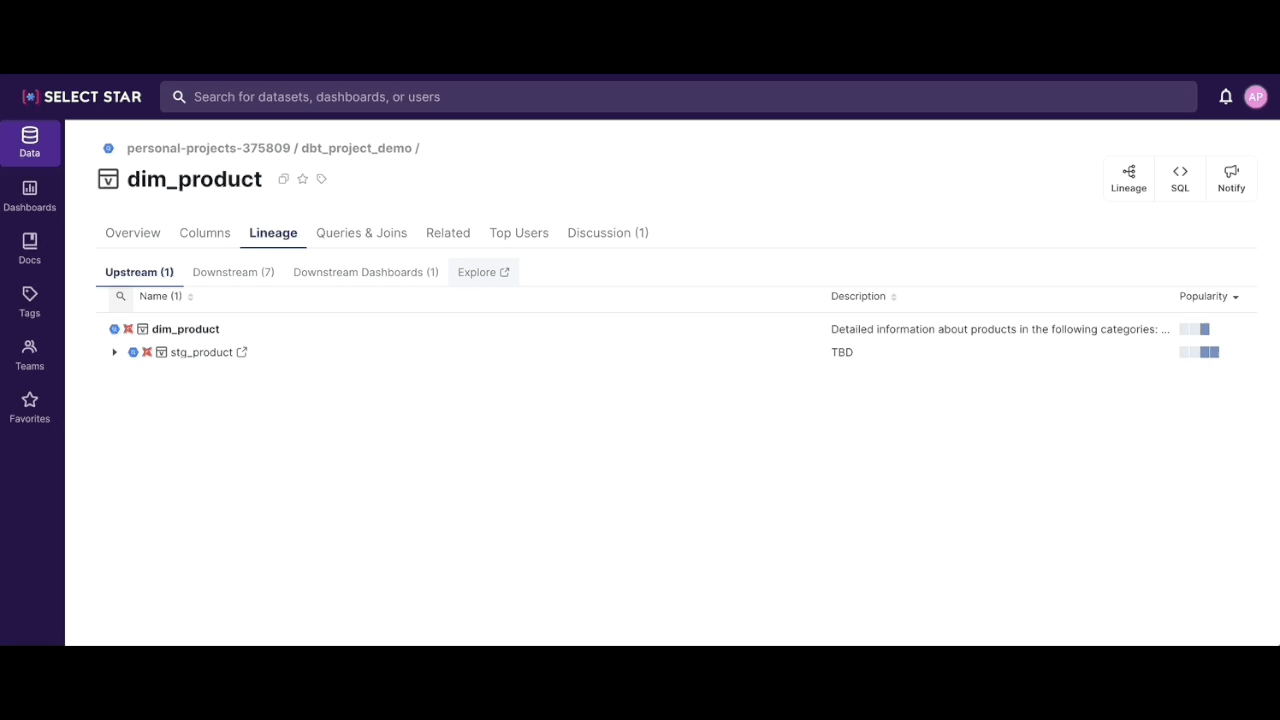
2.4 Business and regulatory requirements
Evaluating the legal, compliance, and business implications of deprecating data is essential to mitigate risks and ensure adherence to relevant regulations and policies.
Step 3: Develop a deprecation plan
Based on the impact analysis findings, create a comprehensive deprecation plan that outlines the timeline, steps, and communication strategy. Use the Discussions feature in Select Star to proactively communicate upcoming changes to the data set or report owner.

Alternatively, you can use the Downstream Notifications feature to quickly inform the top users of data assets or downstream owners when there is an update or upcoming breaking change.
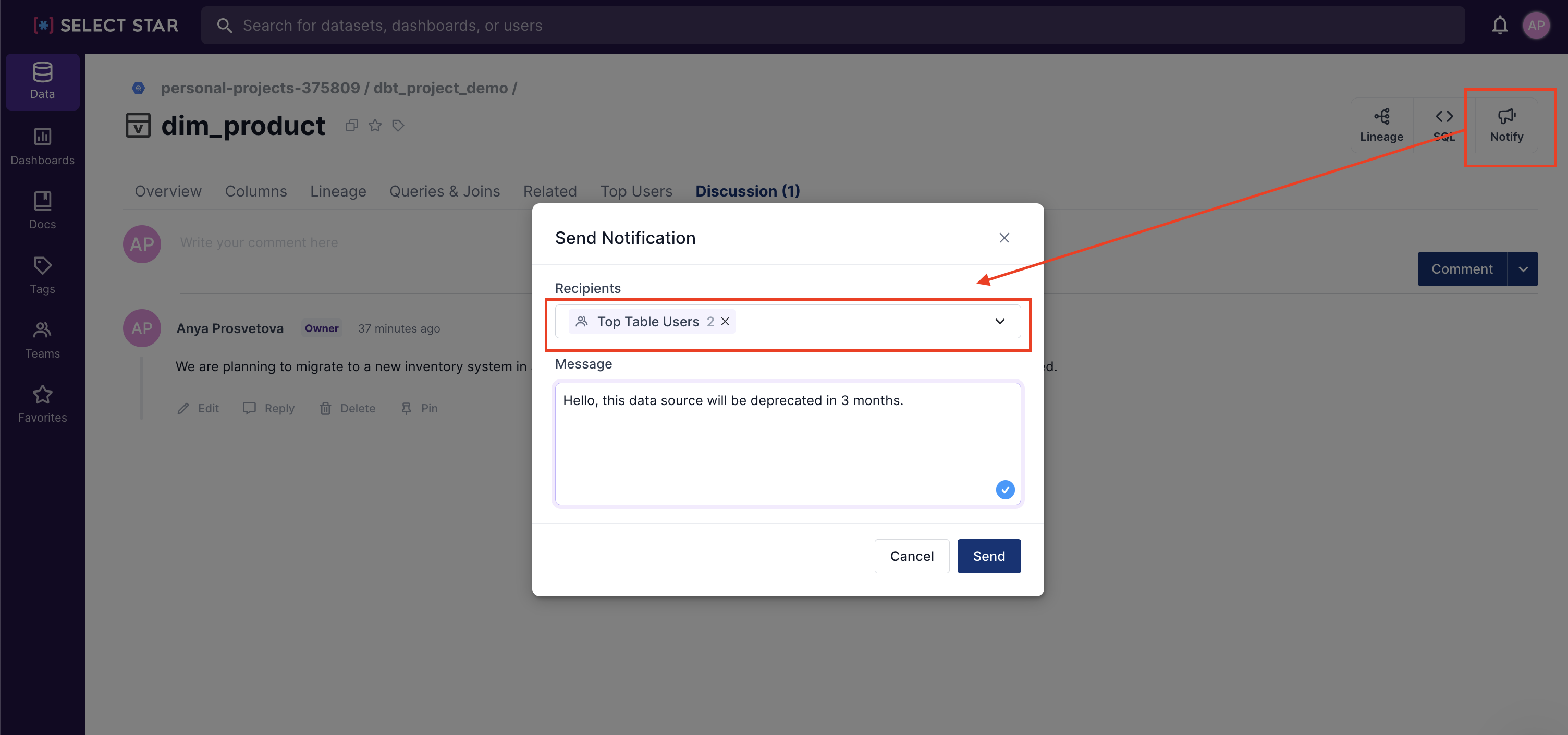
Identify alternative data sources or fields that can replace the deprecated data, if necessary. Clearly document the deprecation process, including the steps for updating data pipelines, modifying access controls, and archiving or deleting the deprecated data.
Step 4: Implement the deprecation
Once the deprecation plan is finalized and communicated to relevant stakeholders, it’s time to execute it. Update data pipelines and downstream processes to ensure a smooth transition to alternative data sources or fields, if relevant. Modify data access and permissions to restrict access to the deprecated data. Archive or delete the deprecated data in accordance with the organization’s data retention policies and regulatory requirements. You can use Select Star’s tagging functionality to clearly mark deprecated data sources or data sources that have been scheduled for deprecation or update.

Step 5: Monitor and validate post-deprecation
After the deprecation process is complete, it’s essential to monitor and validate the data ecosystem to ensure the desired outcomes are achieved. Track data usage and access patterns to verify that the deprecated data is no longer being consumed. Use Select Star’s schema change detection feature to monitor the post-deprecation environment and catch any broken queries or downstream reports.
Verify data integrity and consistency to ensure that the transition to alternative data sources or fields has not introduced any data quality issues. Gather feedback from stakeholders to assess the impact of the deprecation and identify any areas for improvement.
Best Practices for Successful Data Deprecation
To ensure a successful data deprecation process, organizations should consider the following best practices:
- Establish clear deprecation policies and procedures that outline the criteria, roles, and responsibilities involved in the deprecation process.
- Engage stakeholders throughout the deprecation process to gather their input, address their concerns, and ensure buy-in.
- Provide adequate notice and communication to affected users, giving them sufficient time to prepare for the transition and adapt their workflows.
- Ensure data quality and integrity during and after deprecation by implementing robust data validation and reconciliation processes.
- Continuously monitor and optimize the data ecosystem to identify future deprecation candidates and proactively address data quality and relevance issues.
Deprecating data sources and fields is a critical aspect of maintaining a clean, efficient, and trustworthy data ecosystem. By adopting a proactive approach to data deprecation and following best practices, organizations can reap the benefits of a streamlined data environment, reduced storage costs, and improved data quality.
By leveraging the capabilities of Select Star, organizations can confidently navigate the complexities of data deprecation, conduct thorough impact analyses, and execute deprecation plans with minimal disruption to business operations. Select Star empowers data teams to make informed decisions about data deprecation, ensuring that the right data is available to the right stakeholders at the right time.
The article was originally published on Select Star’s blog.